Log Home on Westwood Road
Friday, November 1st, 2024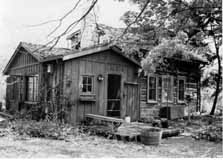 Ann Conner allowed me to see the inside of her 168 Westwood Road home when I was working on my book. You can get a glimpse of it here, in a 1988 10tv item.
Ann Conner allowed me to see the inside of her 168 Westwood Road home when I was working on my book. You can get a glimpse of it here, in a 1988 10tv item.
Or here, as an AirBnB listing.
 Ann Conner allowed me to see the inside of her 168 Westwood Road home when I was working on my book. You can get a glimpse of it here, in a 1988 10tv item.
Ann Conner allowed me to see the inside of her 168 Westwood Road home when I was working on my book. You can get a glimpse of it here, in a 1988 10tv item.
Or here, as an AirBnB listing.
Here are some cool links for old maps:
City of Columbus Planning Maps, Historic Maps.


The City of Columbus’ web site gives us plenty of maps and data to play with, from Census demographic changes to despicable redlining and more. Check out especially the “City of Columbus Historic Panoramic Images, 1922,” which is based on a 1922 Ohio State University masters thesis by Forest Ira Blanchard. “Blanchard, inspired by the Chicago School of Sociology, sought to study the racial and ethnic composition of the city, with a particular focus on the role of transportation (railroads, roads) in shaping the urban landscape. Source: Forest Ira Blanchard, An Introduction to the Economic and Social Geography of Columbus, Ohio. Thesis (M.A.), Ohio State University, 1922.”
Columbus Metropolitan Library’s Columbus and Ohio Map Collection. If you haven’t donated to the library yet, now’s the time! It and and it’s staff are such great resources.
Sanborn Maps for Franklin County (scroll down to see Columbus). This is a Library of Congress site.
USGS Historical Topographic Map Explorer allows you to specify a place you want to explore, then click on a location to see its historical maps.
Prolific programmer Randy Majors has produced several products of interest, including his Historical U.S. Counties Map Tool and Auto-Checker Extension. He has also created a couple of video walkthroughs of a couple of the the software tools he has created. I recommend you view them in order, as understanding the Historical U.S. Counties map tool will help you have better success with using the Auto-Checker chrome extension.
Old Maps Online OldMapsOnline.org indexes over 400,000 maps, thanks to the archives and libraries that were open to the idea and provided their online content.
Do you know of other map resources? Let me know and I will add them to this post.
This is a nice photo from a 1922 Ohio State University masters thesis by Forest Ira Blanchard. I believe, based on the metadata, that it was taken at 2734 Indianola Ave. It is captioned, “Glen Echo section beyond the ravine.”
Blanchard, inspired by the Chicago School of Sociology, sought to study the racial and ethnic composition of the city of Columbus, with a particular focus on the role of transportation (railroads, roads) in shaping the urban landscape.
[Courtesy of Forest Ira Blanchard, An Introduction to the Economic and Social Geography of Columbus, Ohio. Thesis (M.A.), Ohio State University, 1922; digital version from City of Columbus Historic Map Collection.]

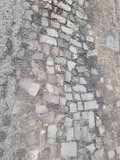 Katie Knostman has shared some photos of the old pavers on Olentangy Blvd at Rustic Place (near the driveway for 4783 Olentangy Blvd), exposed during the recent construction that the residents of Old Beechwold have been enduring.
Katie Knostman has shared some photos of the old pavers on Olentangy Blvd at Rustic Place (near the driveway for 4783 Olentangy Blvd), exposed during the recent construction that the residents of Old Beechwold have been enduring.
On close inspection, two of the bricks say Hocking Dunn Patent):
And on the topic of bricks: Here is a photo of a brick that Clintonville Historical Society has in its archive.
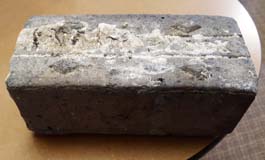
CHS actually has 2 bricks. According to Mary Rodgers: “These are the actual pavers from the street [near American Vitrified Products, which was located on the former site of North High School at Arcadia and Calumet]. The official name of the brick is covered in mortar. You can see the diamonds. Those keep the horses from slipping when the bricks are wet. We might try to remove the mortar from one. It is interesting. They are porous–lighter than I thought…I have seen some articles that are associated with the early use of site. William Wassell seems like an interesting character. They made pipe and bricks. Supposedly, this is one of their bricks. In the late 1800s, they made a fountain for the fairgrounds-all out of pipe. I would love to find a photo of that!” Here’s an article about the fountain.
And finally, a house on East North Broadway has many bricks lining the driveway. These may have come from that roadbed.
[Photos courtesy of Katie Knostman, and Mary Rodgers and the CHS.]
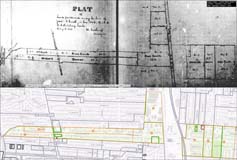 Joseph Wilton Smith IV recently contacted me. Joe’s ancestors owned a house at the southeast corner of East North Broadway and North High Streets, perhaps where the Cochran House was before it was demolished…or–as Mary Rodgers speculated in the May 2020 CHS Newsletter– possibly that very house. Joe has kindly sent along an image that includes several maps:
Joseph Wilton Smith IV recently contacted me. Joe’s ancestors owned a house at the southeast corner of East North Broadway and North High Streets, perhaps where the Cochran House was before it was demolished…or–as Mary Rodgers speculated in the May 2020 CHS Newsletter– possibly that very house. Joe has kindly sent along an image that includes several maps:
1) An 1875 map of the legal division of Joseph Wilson Smith’s farmland in Clintonville, Ohio to his heirs
2) A modern map extracted from the website of the Franklin County Auditor that outlines these lands in orange over the current Clintonville area streets. And,
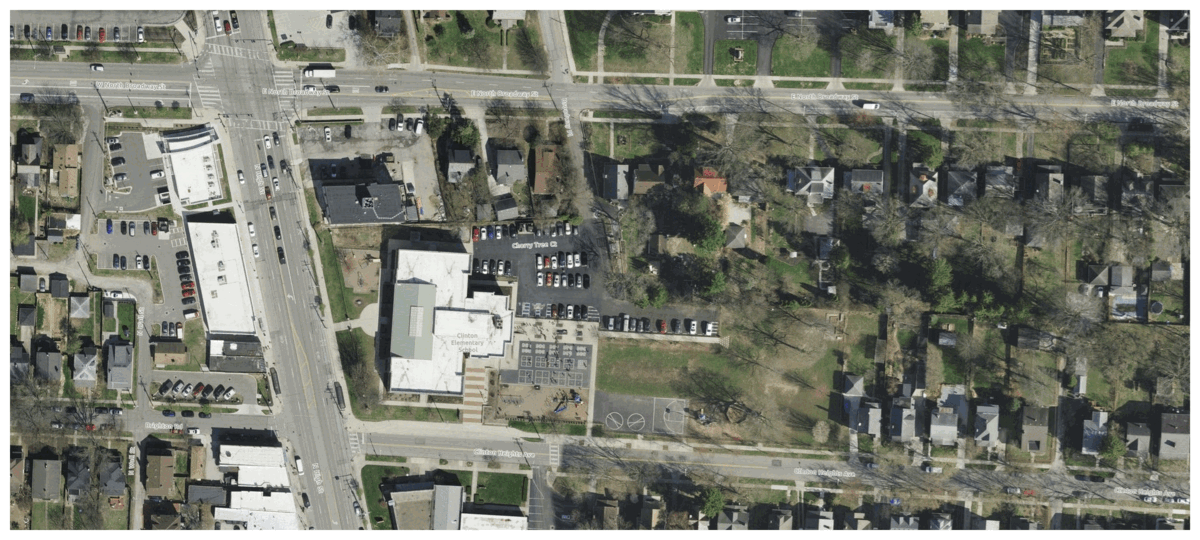
3) The property lines from the 1910 Baist map superimposed on the 2023 satellite view of E.N Broadway and N High.
Joe writes:
I am a direct descendent of three early Clintonville settlers: Thomas Bull, Deacon John Smith, and Pirum Hunt.
I am named after my grandfather, who was named after his grandfather, who was named (sort of) after his father, Joseph Wilson Smith. His wife, Catharine Gray (Piatt) Smith was my third great-grandmother. For the past three months, I have been working closely with Mary Rodgers to sponsor a historical marker honoring my ancestors and their contributions to early Clintonville. My great-grandfather was Roy Ripley Smith, who lived at 145 W. Royal Forest Blvd. in Beechwold. My dad told me Roy also owned a farm that later became part of Highbanks Metro Park.
 In January 2024, Joe Smith gave a presentation to the Clintonville Historical Society about his ancestors, and most especially his ancestor Deacon John Smith. John was a churchman and also an abolitionist in our area. Joe’s presentation is also a great example of what you can do if you set about researching your family’s history.
In January 2024, Joe Smith gave a presentation to the Clintonville Historical Society about his ancestors, and most especially his ancestor Deacon John Smith. John was a churchman and also an abolitionist in our area. Joe’s presentation is also a great example of what you can do if you set about researching your family’s history.
Joe’s presentation can be found here. The handout for that presentation can be found here.
Thanks Joe!
[Thanks to Joe Smith for sharing his research and his presentation. He welcomes additional information and input on his research, and extends his thanks in advance. Contributors to his research include Sharon Hendershot, Nancy J. Pendleton, Mary Rodgers, Elizabeth Renker, and Kathie Smith Brzoska.]
Sometimes a house tells the story of a person, right? In this case the story is about Frank and Bertha Rorer.
This story was sent to me by Wendy Bayer, who writes, “During COVID, I did quite a bit of walking around Clintonville and found myself on West Kanawha one afternoon…I noticed an intriguing house at 314 W Kanawha and did some research on it (naturally! My curiosity is so strong!) I found this great newspaper article from 1939 about the builders and residents; you might find them interesting, too.”
The Rorers bought a tract of undeveloped land on what is now West Kanawha. They took scout troops there, and hiked their property. Their first house on Kanawha was a tiny house constructed from washing machine crates. (Why? because Mr. Rorer was a plumber.) They also built a cave on the property for refrigeration. They initially used this tiny house as a weekend getaway, but Bertha spent more and more time there. Later they built a white clapboard house nearby, and then in the late 1930s they built their dream house at 314 West Kanawha from salvaged walnut-wood logs.
Today there are a cluster of properties along Kanawha formerly affiliated with the Rorers; here are some of their ownership histories:
290 W. Kanawha–nothing
300 W. Kanawha–1922-1937 Rorers owned it. This is where they lived in April 1931.
304 W. Kanawha–1923-1959 Rorers owned it, new house built 1959
310 W. Kanawha–1937-1959 Rorers owned it, new house built 1960
314 W. Kanawha–log home. Rorers owned it 1923?-59
320 W. Kanawha– nothing
Here’s the “Ohio Historic Inventory sheet” for 314 West Kanawha, from the Ohio Historic Preservation Office at Ohio History Connection.
Bertha Rorer died in 1974, her husband Frank Rorer died 1976 (You can click through to read their obituaries.)
[Research courtesy of Wendy Bauer, and inventory courtesy of Nancy Campbell/OHPO.]
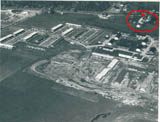 In April 2024 I wrote that Flora Hess sold her property, a flower shop at the intersection of Dodridge and Olentangy River Road, to the state in 1932. She lived in a house close by at 2637 Olentangy River Road; in 1968 Johnny Jones wrote an article about an antique sale at the Hess homestead.
In April 2024 I wrote that Flora Hess sold her property, a flower shop at the intersection of Dodridge and Olentangy River Road, to the state in 1932. She lived in a house close by at 2637 Olentangy River Road; in 1968 Johnny Jones wrote an article about an antique sale at the Hess homestead.
I believe Flora lived in that house for many years. She ran the property as a trailer park from at least the 1930s until the late 1940s. I found several Columbus Dispatch articles that reported her conviction in 1946 of illegally operating a trailer camp on the property. The county had declined to issue her a permit because the property did not meet sanitary requirements. The trailers were mostly occupied by students. I also found many ads for sales of trailers, so the land may have been a dealership. I would love to have learned her side of this story.
The Ohio State University archives has some aerial photos of the old Hess farm with what Jones described as “part of an old windmill;” there’s a map in the collection’s finding aid and you can see the set of aerials here.
Now here’s the sad, sad, story about this homestead. According to a Hess family historian, Flora’s father John Moses Hess Jr. “received his education in the public schools of Franklin County and later attended Otterbein University. He was a farmer all his life. Uncle Moses was well over six feet tall, quiet and easy going. He always had a well groomed driving horse and took me on several Sunday afternoon drives in the north end of Franklin County, telling the history of the Dublin community. I never saw him when he was not wearing a stiff bosomed white shirt. This was one of his several oddities. Aunt Hannah was very opposite, being small and wiry and a human dynamo, and I always marveled how one so small could turn out so much work. Aunt Hannah died August 17, 1922, being murdered by an irresponsible farm hand who died from self-inflicted wounds the following day. Uncle Moses died December 15, 1923 and both are buried in Union Cemetery across the road from the farm home.” You can read the details of this sad tale of murder and suicide is the Columbus Dispatch here.
Flora died in 1962 (b. 06 Mar 1883, d. 06 Nov 1962) and is buried in Union Cemetery near her parents. Her sister Elizabeth died in 1968 at age 89 (b.30 Sep 1879 d. 5 Dec 1968) and is also buried there.
[Photos courtesy of The Ohio State University Archives. Research help courtesy of Harry Campbell.]
 These lovely pictures are of the Albrecht Floral Shop at 2703 River (or Olentangy) Road–the intersection of Dodridge and Olentangy River Road, looking north.
These lovely pictures are of the Albrecht Floral Shop at 2703 River (or Olentangy) Road–the intersection of Dodridge and Olentangy River Road, looking north.
According to librarian Cindy at the Columbus Metropolitan Library, the flower shop went through several hands in the 1930s.
 In 1941 it finally appears as Albrecht Florists.
In 1941 it finally appears as Albrecht Florists. Cindy found a parcel sheet for what she believes is the property in question. The parcel sheet shows the greenhouse listed as well as a brick building.
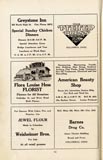 There is an ad for Flora Louise Hess, Florist in a 1925 Columbus Women’s Club cookbook that features an illustration of the building matching these photos.
There is an ad for Flora Louise Hess, Florist in a 1925 Columbus Women’s Club cookbook that features an illustration of the building matching these photos.
Flora Hess sold the property to the state in 1932. She lived in a house close by at 2637 Olentangy River Road, however. In 1968 Johnny Jones wrote an article about an antique sale at the Hess homestead.
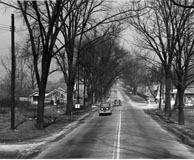 Across the street from the flower shop is a gas station. The Moosehead Filling Station and Moosehead Tavern was across the street at 2696 Olentangy Road as early as 1937. It advertised selling H-C gas; H-C was the first high-octane gasoline. In 1926, Sinclair leapt ahead of most of its competitors with H-C, the industry’s original high-octane premium gasoline for motorcars. The 72-octane auto fuel, developed at its Houston refinery, was better than anything then marketed (Lindbergh’s flight to Paris the following year was on 73-octane gasoline). H-C stood for “Houston Concentrate,” though some advertising men called it “High Compression.”
Across the street from the flower shop is a gas station. The Moosehead Filling Station and Moosehead Tavern was across the street at 2696 Olentangy Road as early as 1937. It advertised selling H-C gas; H-C was the first high-octane gasoline. In 1926, Sinclair leapt ahead of most of its competitors with H-C, the industry’s original high-octane premium gasoline for motorcars. The 72-octane auto fuel, developed at its Houston refinery, was better than anything then marketed (Lindbergh’s flight to Paris the following year was on 73-octane gasoline). H-C stood for “Houston Concentrate,” though some advertising men called it “High Compression.”
The Moosewood Tavern was apparently a trouble spot; this Columbus Dispatch newspaper article documents one incident of rowdiness.
[Photos courtesy of the Franklin County Engineers. Articles are from the Columbus Dispatch. Research on these photos and news items mostly came from Cindy at the Columbus Metropolitan Library Local History & Genealogy Desk; thank you Cindy! ]
Eric Hartzell has been helping Jack Smith–of Smith’s Deli fame at 3737 N. High Street–rewire parts of the deli, and with some repairs. Along the way, Eric has found some fabulous pictures related to the deli.
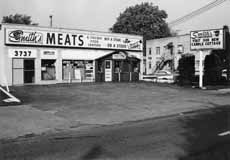 First, the deli when it was a meat and frozen food center, and–get this–candle store! Eric estimates this picture is from around the mid-1960s.
First, the deli when it was a meat and frozen food center, and–get this–candle store! Eric estimates this picture is from around the mid-1960s.
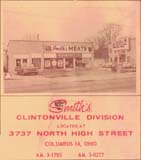 Here’s another picture courtesy of The Clintonville Spotlight October 01, 2020.
Here’s another picture courtesy of The Clintonville Spotlight October 01, 2020.
Eric writes, “The first picture above seems to be from late 1960s judging by the cars on the side lot….maybe 1968…or it could be early 70’s. But it is different from the pic in that ad or menu…It is 1961-62 because of the car out front. But the sign on the top of the building is much bigger and goes from end to end on the building….and has the added candle and candy shop on the right end. Since they didn’t discontinue the meat part till 1982…..hard to completely say.”
 In the early 1940s the site was Beem Motors, a Packard dealership; this ad is from a 1941 telephone book. There was an auto service station & filling station next door at 3729 N High Street at least as early as 1941 (but not before 1932). As Eric writes, “…[The car dealership] is the reason the 1920’s style garage/gas station is right next to it. There is even a garage door still inside Smith’s Deli right behind the pizza ovens. It was never removed, and infrastructure was just built around it.” By 1943, 3737 N High Street was a grocery, and by 1951 it had become Clintonville Lockers Frozen Food Lockers owned by Guy B. Harris. Jack Smith’s dad purchased the business in 1961.
In the early 1940s the site was Beem Motors, a Packard dealership; this ad is from a 1941 telephone book. There was an auto service station & filling station next door at 3729 N High Street at least as early as 1941 (but not before 1932). As Eric writes, “…[The car dealership] is the reason the 1920’s style garage/gas station is right next to it. There is even a garage door still inside Smith’s Deli right behind the pizza ovens. It was never removed, and infrastructure was just built around it.” By 1943, 3737 N High Street was a grocery, and by 1951 it had become Clintonville Lockers Frozen Food Lockers owned by Guy B. Harris. Jack Smith’s dad purchased the business in 1961.
Here’s a link to an aerial photo of that location from an unknown year. You can see the auto service center to the south of Smith’s.
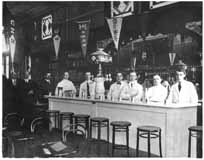 And about Smith’s arch and counter, Eric writes: “When I asked Jack if I could rewire the arch for safety sake..(it was still with the original 1907 wiring) I started to also do the research on it. All he could tell me was that it came from a Chillicothe drug store, named A.B. Howson’s Pharmacy in the famous Carisle Building. Didn’t take long to find a picture of it inside that drug store with the help of the historical society down there. Was like finding buried treasure, there it was from a picture taken in 1909. It was built in 1907. Now [the arch] has 100% LED lights….even used the new LED Edison style lamps that really gave it that old time look. The drug store closed in 1967….or was it 1969….anyway, that was when his father purchased it and moved it to the current store, marble and all. More about the drugstore, including the names of the boys staffing the counter here.
And about Smith’s arch and counter, Eric writes: “When I asked Jack if I could rewire the arch for safety sake..(it was still with the original 1907 wiring) I started to also do the research on it. All he could tell me was that it came from a Chillicothe drug store, named A.B. Howson’s Pharmacy in the famous Carisle Building. Didn’t take long to find a picture of it inside that drug store with the help of the historical society down there. Was like finding buried treasure, there it was from a picture taken in 1909. It was built in 1907. Now [the arch] has 100% LED lights….even used the new LED Edison style lamps that really gave it that old time look. The drug store closed in 1967….or was it 1969….anyway, that was when his father purchased it and moved it to the current store, marble and all. More about the drugstore, including the names of the boys staffing the counter here.
Thanks for sharing, Eric!
[Images courtesy of Eric and his original sources, and to Dave Wenger at Northend Wrench for the aerial photo.]
Here’s a very sad story about one of our Clintonville residents from former times. James Welsh, commonly called Jerry, was a dairyman along High Street. His farm burned on January 27, 1897, and Jerry was himself badly burned in the fire. Jerry survived the fire, however, and he eventually died on Sept 5, 1905 at the age of 72 or 73 of dropsy (edema, or heart failure). He was originally from Ireland, was a Civil War veteran, and is buried in Mount Calvary Cemetery.
There’s no record of his having owned a farm on High Street or in Clinton Township, so perhaps he leased the farm land. When he died, Jerry lived at 34 Richards Road with his wife Bridget; I presume he lived close to his dairy farm. The couple also lived with a lad named Fay Osborn; Osborn is likely the 14-year old boy who was also at the scene of the 1897 fire and who was credited with saving the 20 cows.
Dairy Barn Burned
Cows Saved With Difficulty From the Flames–Loss $900.The big dairy barn of Jerry Welsh on High street above Clintonville was totally destroyed by fire Tuesday afternoon, together with a stock of fodder. In the barn at the time the blaze was discovered were about 2[0] cows and some horses. All the animals were finally removed though Welsh and his neighbors had a lively time of it taking the frantic beasts from the fiery furnace.
Luckily there was little, if any, wind and the other outbuildings and the house were saved.
There was no means of fighting the fire, and all that could be done was to run to the neighbors’ for buckets of water to pour upon the house. About [6]00 tons of millet was burned. The loss on the property will be about $900.
Nearly a Tragedy
Was Fire at Jerry Welch’s
Dairy BarnMr. Welch Himself Badly Burned And Narrowly Escaped Death
There came near being a tragedy at the fire above Clintonville Tuesday afternoon.
It will be remembered that Jerry Welch’s big dairy barn was totally destroyed, as stated in The Dispatch at the time.
It seems that Welch, who is quite an old man, was in the barn when the fire broke out, but became so excited that had it not been for the efforts of a 14-year-old boy who was in an adjoining field gathering fodder, over 20 cows would have been burned. The lad released the maddened animals just as the roof of the structure fell in.
All this time Welch was working heroically at the other end of the barn endeavoring to save the horses. In some way he slipped and fell right into the awful furnace. He was dragged therefrom by a neighbor who had hastened to the scene. Welch’s hair was singed, his hand and face badly scorched, and he would have burned to death had not the neighbor pulled him out and extinguished the fire by rolling the victim in the snow.
Cindy at the Columbus Metropolitan Library shared most of the above details about Mr. Welsh with us. She writes: “I was able to find a little more information about Jerry Welsh. First, I believe the name was actually Welsh, not Welch [as in the 2nd article above]…I am attaching Mr. Welsh’s obituary. I was able to find him on the 1900 census with his wife, and it looks like he was a veteran of the Civil War because I found a grave registration card that matches up with his grave information in Mount Calvary Cemetery. Unfortunately, I was not able to find that he owned any property in Clinton Township. I checked maps, including a 1895 plat map that has landowners names on it. I also checked deed indexes on the recorder’s site for that time frame for both grantors and grantees and still did not find anything. It is possible he was renting the land that the barn was on.”
I do love our Columbus Metropolitan Library System and especially appreciate the Local History and Genealogy staff. THANK YOU CINDY!
[Newspaper articles from the Columbus Evening Dispatch Jan 27, 1897 and the Columbus Dispatch Thursday Jan 28, 1897. Research ny Cindy at the Columbus Metropolitan Library Local History & Genealogy Desk.]